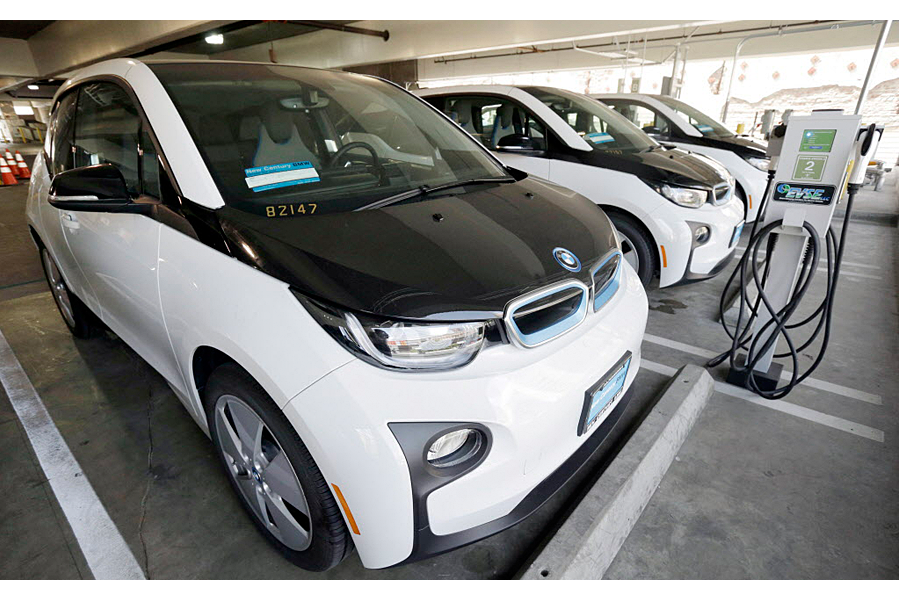BMW's recycled electric car batteries to power homes
Loading...
BMW wants to make throwing away car batteries a thing of the past.
The German automaker says it will soon recycle the battery cells of its i3 electric vehicle by installing them in homes, providing a family with enough electricity for up to two days.
The company says it will offer a standalone energy storage system in the near future, which its new and used i3 batteries will power, in an announcement on Tuesday at the electric vehicle symposium EVS29 in Montreal.
BMW will be the first electric vehicle manufacturer to recycle its batteries for use on homes. It’s not the first to develop standalone energy storage systems, however. Tesla’s Powerwall has received the most attention, although a host of other automakers have developed their own versions. As they do, they are dissolving the line between home and vehicle energy as they and electricity producers shift away from fossil fuels.
"With a battery storage system electrified by BMW i our customers can take the next step towards a sustainable energy lifestyle. Coupled with the home charging and solar energy programs, the system enables BMW drivers to embrace holistic sustainability beyond e-mobility," said Rob Healey, BMW North America’s manager of electric vehicle infrastructure, in a statement.
BMW’s system is straightforward. The unit will be connected to a home’s electrical grid, storing electricity either generated by rooftop solar or bought at a low rate from energy providers. The module can hold 22 kilowatt-hour (kWh) or 33 kWh capacity batteries. The average home in the US consumed 15kWh to 30kWh per day in 2014.
Where BMW seeks to stand apart is with its i3 batteries, which it says users will be able to recycle by installing them into charging modules when they are no longer reliable enough to power electric vehicles. Once the modules become available, it’s likely that customers will first have to buy new i3 batteries because the vehicle has been produced only since 2013 and there is no oversupply of used batteries. Regardless, the announcement of this option has highlighted automakers’ interest in electricity.
While Tesla has received the most attention, numerous automakers have been actively testing standalone energy storage units, reported Greentech Media. Tesla’s Powerwall can store 6.4 kWh of electricity, enough to power a home in the evening, when home energy use is highest, and a solar installation won’t generate power. Tesla’s sales of its luxury electric vehicles has given it the purchasing power to buy materials for battery production at a lower price than its competitors, as Rowena Lindsay reported for The Christian Science Monitor last year. And its $5 billion Gigafactory in Nevada has turned heads.
Meanwhile, BMW entered into a program with Pacific Gas and Electric (PG&E) in which the California utility provider manages 100 kilowatts of demand from BMW. A stationary unit made up of repurposed i3 batteries in Mountain View, Calif., charges 100 BMW i3 vehicles, according to Greentech Media. When there is an energy shortage on the grid, PG&E alerts BMW, who switches off the charging stations.
Daimler AG, BMW’s German competitor, has recycled electric vehicle batteries to power its recycling plant in Lünen, Germany. Daimler claims the 13-megwatt-hour battery storage unit is the largest in the world that uses second-life electric vehicle batteries, according to Greentech Media. Daimler also announced a year ago it will offer home energy storage units in Europe, and there are rumors it will expand this offering to the US in the fall.
Meanwhile, Toyota, General Motors, and Nissan are testing stationary energy storage and “looking to make larger plays,” according to Greentech media.
Researchers at the University of Delaware are also working developing technology to have electricity flow from electric vehicles to homes and vice versa because “Electric-drive vehicles, whether powered by batteries, fuel cells, or gasoline hybrids, have within them the energy source and power electronics capable of producing” electricity for our homes or offices.







